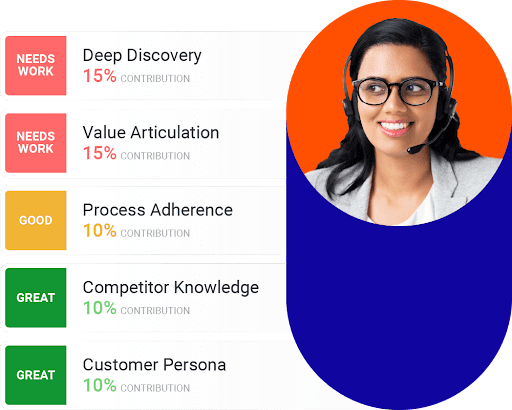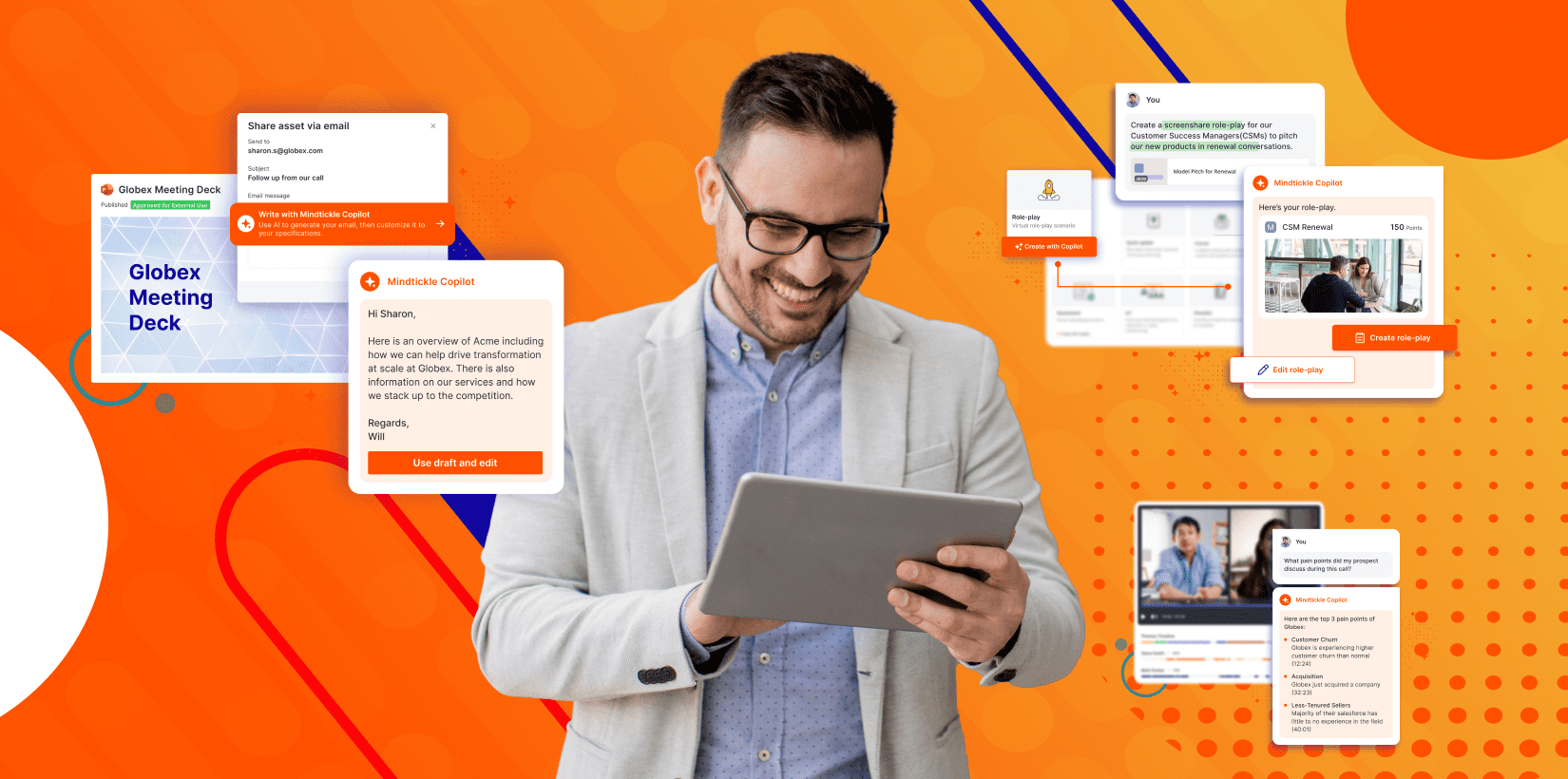As a business leader, you understand enterprise learning and development’s important role in organizational success.
By offering employees the right learning and development opportunities, you’re helping them build the skills and behaviors they need to reach their full potential and propel your organization forward.
The right technology is essential to any learning and development program. With the right tools and technology, learning and development teams can more effectively and efficiently create and deliver training and learning programs – and measure their impact on employees’ behaviors and business outcomes.
A learning content management system is an important tool for learning and development pros. But what is it?
In this post, we’ll define a learning content management system and explain how this technology is different (and similar) to a learning management system. We’ll also explore some of the must-have features to consider when considering software and some of the most popular options today.
What is a learning content management system (LCMS)?
First things first: what is a learning content management system?
Also known as an LCMS, it’s a software solution that enables learning and development teams to develop and distribute training and enterprise learning content.
Some learning technology is built primarily for L&D teams or learners. On the other hand, a learning content management system is built to meet the needs of both parties.
For the learning and development team, an LCMS serves as a one-stop shop for managing everything related to learning content. With the right learning content management system, L&D teams can efficiently create digital learning content and learning paths and assign learning to users. L&D teams can also leverage the LCMS to measure learning consumption. Ideally, these teams should also be able to get insight into how their learning initiatives are impacting outcomes.
A learning content management system is also built for learners. Employees can turn to the LCMS to find everything they need related to training and learning. There, they can find learning opportunities tailored to their needs – and be sure they’re accessing the latest and most excellent versions of everything.
LCMS vs LMS: What’s the difference?
Chances are, you’re familiar with the concept of a learning management system – or LMS for short. You may be wondering how a LMS compares to an LCMS.
Learning content management systems and learning management systems are certainly related. But while the terms may be used synonymously, they’re not the same thing.
LCMS vs LMS: Key differences
A learning management system (LMS) is software that enables organizations to organize and distribute eLearning courses and content to users. First, L&D teams create learning content and courses in a separate authoring tool or platform. Then, they can upload content and courses to the LMS. Learners log on to the LMS to find and consume eLearning content. Admins can access basic tracking information, like how many learners have completed a course and passed a specific assessment.
Think of these platforms as the next level of LMSs. They typically provide the same functionality as an LMS – but with additional capabilities for creating, curating, and managing enterprise learning content.
L&D teams use learning content management software to manage the entire lifecycle of learning content. Teams can plan, create, and deliver learning content – all from one platform. A platform also provides robust analytics that shed light on how learners consume content. For example, you can see how long an employee spent on specific training and how they answered each question in an assessment. Some LCMSs also provide insight into whether elearning consumption is tied to improved performance and outcomes.
Another key difference is that learning management systems are primarily built to meet the needs of students. On the other hand, learning content management systems are focused on delivering excellent experiences to administrators and learners alike.
LCMS vs LMS: Key similarities
Of course, there are also similarities between learning content management platforms and learning management platforms. Namely, both are tools used by learning and development teams to deliver training and learning that helps users gain the skills and knowledge they need to be effective and efficient in their roles.
Essential features of a learning content management system
If you run a quick Google search for “learning content management system,” you’ll see plenty of options. However, not all software is the same. Each LCMS offers a unique set of features and functionality. Furthermore, some platforms that claim to be an LCMS aren’t.
When comparing your options, be sure to look for certain must-haves.
#1 Easy to use workflows
Investing in an LCMS should make your life easier, so find an intuitive and easy-to-use option.
Administrators and subject matter experts should be able to quickly and easily create new content without mastering new skills. Look for an LCMS that provides templates that can serve as a starting point for creating new material.
A recent analysis of Mindtickle activity found that it takes companies an average of 3-4 weeks to launch a new program from scratch. However, organizations can launch programs in seven days when they start with a program template.
Time to launch a program
Your chosen LCMS should also provide the option to create a variety of different types of e-learning, including:
- Videos
- Presentations
- Printed materials
- Microlearning
- Paced reinforcement
- Practice opportunities, including role-plays
It’s also important to ensure the LCMS is easy for learners to use. If there’s a steep learning curve, your employees may avoid using it.
#2 Mobile-friendly
Learning doesn’t just happen in a classroom setting. Instead, it can happen anywhere.
Be sure your chosen LCMS is mobile-friendly. That way, employees can access the right enterprise learning content wherever and whenever needed.
#3 Customized courses and learning modules
Each employee brings a unique set of strengths, weaknesses, and experiences. Furthermore, every team member has preferences regarding how they learn best. A one-size-fits-all approach to learning just won’t cut it. Instead, organizations must embrace individualized learning.
Courses and learning paths must be tailored to each employee’s needs. That way, users spend their time on content that will actually help them boost lagging skills—and not waste their time on irrelevant content.
Be sure your LCMS has features and functionality that make it easy to pinpoint each employee’s strengths and weaknesses. Your learning content management system should then make it easy to deliver customized courses and learning paths relevant to each user. Also, look for an option leveraging AI to recommend learning content to users based on their knowledge level and preferences.
#4 User activity and progress tracking
Creating great learning content is pointless if no one engages with it. It’s important to track which users are engaging with what content, and your LCMS should make it easy to do so.
At a minimum, your learning content management platform should allow you to track the basics, like how many users have completed a specific training module or passed a certain assessment. You should also be able to drill down further to see how users engage with sales learning content.
For example, you can see how long employees spend on a learning module, what pages they view most, how many times they view it, and how they answer specific questions. You can look for trends in this data. For example, you may notice that sales reps consistently have low completion rates in a certain region. This is an opportunity to work with the region’s sales leaders to ensure sales reps understand the importance of completing learning modules.
#5 Real-time analytics
As we explored in point #4, it’s important to identify which users are engaging with learning and development content. However, understanding consumption and engagement isn’t enough. After all, a user can complete every learning module assigned to them yet still underperform.
The best teams understand they must look beyond consumption and views to truly understand how sales learning content is impacting outcomes. Your learning content management system should provide the right data, analytics, and integrations to understand impact.
For example, let’s say you have a sales rep who struggles with objection handling. So, you assign them a series of learning content focused on the topic. Of course, your LCMS should allow you to see whether or not they engaged with the learning content. But you should also get insight into how the rep’s behaviors are (or aren’t) changing in the field – and whether they’re doing a better job overcoming objections and closing more deals.
Of course, having access to data doesn’t necessarily mean you know what to do with it. Today, some learning content management solutions leverage AI to make sense of data – and then recommend actions based on it.
#6 Integrations with other important tools
Chances are, you already use a variety of tools and technology. It’s important to ensure that your chosen learning content management system integrates with your existing technology.
Also, remember that adding a new tool to your existing technology stack isn’t always the best option. According to Salesforce’s 2023 State of Sales report, nearly 70% of sales reps are overwhelmed by the number of tools they’re expected to use.
According to research,
Instead, look for opportunities to streamline your tech stack by trading point solutions for integrated platforms. For example, an integrated revenue enablement platform incorporates learning content management capabilities, training, enablement, coaching, conversation intelligence, sales content, digital sales rooms, and more.
#7 A commitment to continuous innovation
In the world of business, change is the only constant. While your chosen learning content management system may meet your needs today, it is important to find a vendor committed to continuous innovation.
For example, some learning content management systems are leveraging artificial intelligence (AI) to drive even better experiences for learning and development teams and learners. Some allow administrators to tap into AI to quickly and easily develop and deploy new learning and enablement programs. Others use AI to suggest learning and development resources to learners based on their strengths, weaknesses, learning preferences, and queries.
The best learning content management systems in the market
We’ve explored some of the must-have features of any learning content management system. Now, you may ask yourself, “What’s the best learning content management system out there?”
The answer to that question depends on your organization’s needs and goals. However, a few examples are especially popular in the market today.
Mindtickle
G2 Rating: 4.7 out of 5
Mindtickle is an integrated revenue enablement platform with robust learning content management capabilities for admins and learners alike.
With Mindtickle, learning and development and enablement teams can quickly and easily develop new learning and enablement content. With Mindtickle’s provided templates, teams can launch a new program within seven days.
Of course, learning and development can’t be one-size-fits-all. Fortunately, Mindtickle facilitates individualized learning.
With Mindtickle, organizations can develop ideal rep profiles, which lay out the skills and behaviors different customer-facing roles need for success. Then, teams can measure each employee against the appropriate ideal rep profile to pinpoint their weaknesses.

Equipped with these insights, learning and development and enablement teams can easily create individual learning paths for each employee that help them build lagging skills. AI can also suggest learning content based on individual strengths, weaknesses, and preferences.
Mindtickle also provides a simple, intuitive experience for learners. Employees can access all learning and development content – including onboarding, training, reinforcement, coaching, and practice opportunities – all from a single platform. In addition, Mindtickle is mobile-friendly, which means learners can access what they need whenever and wherever they need it.
In addition, Mindtickle provides robust data and analytics to administrators. Learning and development teams can see who is viewing and engaging with learning content – and how they’re engaging with it.
With Mindtickle, enablement teams can also see how the consumption of learning content impacts business outcomes. For example, they can track how a rep’s in-field behaviors are changing and how key metrics – including close rates and sales cycle lengths- are (or aren’t) improving. Learning and development teams can use these insights to optimize their programs for better performance.
Docebo
G2 Rating: 4.2 out of 5
Docebo is a learning platform that focuses on delivering a great user experience for both admins and learners. Docebo enables admins to create new learning content for employees, partners, and customers.
Docebo leverages AI to automate time-consuming tasks such as translations and content categorization. The platform also leverages AI to enable admins to create learning materials quickly.
Docebo offers an integration with Salesforce, which allows businesses to understand how learning content contributes to revenue performance.
360Learning
G2 Rating: 4.6 out of 5
360Learning is a popular learning platform “powered by collaborative learning.” It includes features that make it easy for subject matter experts to collaborate with learning and development teams to create effective learning content.
360Learning can integrate with many other technologies you already use within your organization. One notable integration is with Salesforce, which allows learning and development teams to understand the impact of learning on sales outcomes.
Bigtincan
G2 Rating: 4.3 out of 5
Bigtincan is a sales enablement platform with learning content management system capabilities. Bigtincan aims to ensure that customer-facing teams have access to learning opportunities that prepare them to deliver great customer experiences.
Bigtincan integrates with technologies you may already be using, including Salesforce, Salesloft, Microsoft Teams, and Gmail. In addition, the platform provides robust data and analytics to help you understand consumption and impact.
The Right Technology for Your L&D Program
Ready to see why winning revenue teams are turning to Mindtickle to build, deploy, and measure learning content that drives real impact?
Get Your Demo

 By Poornima Mohandas
By Poornima Mohandas
 By Helen Waite
By Helen Waite
 By Rahul Mathew
By Rahul Mathew
 New to MINDTICKLE?
New to MINDTICKLE? WHO WE HELP
WHO WE HELP COMPANY
COMPANY RESOURCES
RESOURCES